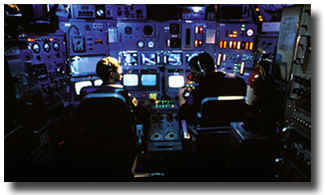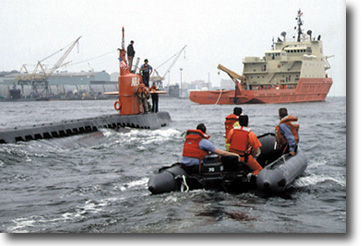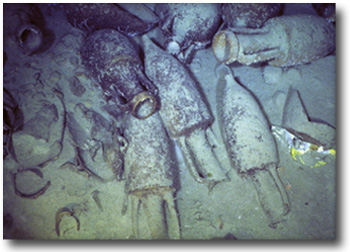|
NR-1 –
|

|
NR-1 –
|
Maneuvering,
Conn, all stop. |
It is the summer of 1997, and the U.S. Navy Submarine NR-1 is deployed to the Mediterranean for the second of two archaeological expeditions in cooperation with Dr. Robert Ballard, discoverer of the remains of the Titanic and Director of the Institute for Exploration in Mystic, Connecticut. NR-1 is assisting in the search for the wrecks of ancient Roman merchant ships on the Skerki Bank between Sardinia and Sicily on an expedition partly funded by the Office of Naval Research and the National Geographic Society. Two years earlier, NR-1 had surveyed the HMHS Britannic, sister ship to the Titanic, which was sunk in the Kea Strait off the coast of Greece while serving as a hospital ship during World War I. Both operations have been the subject of well-received television documentaries. If these sound like unusual assignments for a Navy submarine – they are. But then NR-1 is an unusual boat. One of a Kind NR-1 is a nuclear-powered, deep-submergence submarine, capable of exploring ocean depths to 3,000 feet, which allows access to most of the world’s continental shelves. Displacing just under 400 long tons, she is roughly 1/16th the size of a Los Angeles-class submarine. Although her small size limits the underway crew to a mere three officers and eight enlisted men, the exceptional endurance of her nuclear propulsion plant allows the crew to conduct uninterrupted bottom operations for up to 30 days, restricted only by the food and air purification supplies on board. NR-1 was conceived in the 1960s as a deep-ocean, bottom-exploring submarine by Admiral Hyman G. Rickover. Her turbo-electric drive train culminates in twin 50-horsepower propulsion motors outside the pressure hull, which give a maximum speed of 5 knots. She is also equipped with four ducted thrusters that enable her to maneuver in every direction, even while hovering within inches of the ocean floor. The vehicle also has a conventional rudder and diving planes mounted on the sail for depth control at “high” speed. Launched on 25 January 1969, she is now the second oldest nuclear-powered submarine in the fleet, behind the USS Kamehameha (SSBN-642), four years her senior. Some of NR-1’s unique features include three viewing ports for visual observation, exterior lighting to support both television and still cameras, an object recovery claw, a manipulator arm for various gripping and cutting tools, and a work basket to hold items recovered from the sea. Unlike the smooth, faired black hulls of today’s SSNs and SSBNs, NR-1 is adorned with a bright orange sail, a flat superstructure deck topside, an awkward box keel underneath, and numerous protuberances around the ship, including two retract-able bottoming wheels – mounted with alcohol-filled Goodyear truck tires! These wheels give the ship her unique bottom-sitting and crawling capability. The Mission Commander (OOD) and Pilot (Helm) sit next to each other on the Conn, where they are surrounded by ship control indicators and sonar and surveillance video monitors, much like the flight crew in a cockpit. Perched below the OOD and pilot is the Viewports Station. From here the viewports watch looks through three six-inch thick windows to the ocean floor below. Serving as a lookout and safety-of-ship watch when the submarine is conducting near-bottom operations, he also controls external equipment, such as the ship’s hydraulically-powered manipulator arm, to recover objects weighing up to 250 pounds. He can stow articles in the work module for retrieval at the surface or hook larger, heavier artifacts onto the forward grapnel.  NR-1’s control station provides video monitoring of the near-bottom scene as well as ship’s system status. For video and photographic imaging, the ship is equipped with low-light-level black-and-white video cameras, a color camera, a digital electronic still camera, and two underwater 35mm still cameras. Illumination for oceanographic surveillance is provided by a myriad of thallium iodide and incandescent lights installed from bow to stern on the ship’s underside. She is also equipped with sophisticated electronics and computers for navigation, target location, and data management and an advanced University of Texas/Applied Research Laboratories (ARL-UT) Obstacle Avoid-ance Sonar (OAS). In contrast to conventional oceanographic research vehicles, NR-1’s nuclear propulsion plant gives her the ability to operate independently of surface ships, since it provides ample electrical power for all onboard sensors and life-support systems and gives the ship essentially unlimited endurance. However, due to her size and relatively slow speed on the surface, NR-1 is generally towed while submerged to and from remote mission locations by her dedicated support vessel, the SSV Carolyn Chouest.  NR-1 under tow by her mother ship, SSV Carolyn Chouest. Retracing Ancient Trade Routes In returning to the Mediterranean for the Roman Shipwrecks Expedition in 1997, NR-1 teamed with a highly skilled group of scientists, engineers, and archaeologists, who embarked on board both the submarine and the Carolyn Chouest. Operating in tandem with the JASON Remotely Operated Vehicle (ROV) from Woods Hole Oceano-graphic Institution, Woods Hole, Massachusetts, NR-1 performed wide-area search to identify promising shipwrecks, while marine archaeologists conducted detailed site surveys with the ROV. Working in an area crossed by the early trade routes between Rome and Carthage, NR-1 discovered five previously unknown ancient shipwrecks in water so deep that the remains were only slightly buried by sedimentation. Although the hulls themselves had largely rotted away, the ships’ cargoes – of amphorae, cookwear, and building stone – remained undisturbed on the bottom. A small sampling of these materials was brought to the surface for scientific examination and historical analysis. Because deep ocean bottoms have been largely unexplored until now, there are certain to be many other such sites along ancient sea routes, with well-preserved and hitherto inaccessible nautical artifacts. Historians and archaeologists are increasingly excited by the resulting prospect of a whole new frontier in maritime exploration. Life Underway The NR-1 has been assigned both military and scientific missions over the last 30 years and routinely deploys with her support ship for a five-month mission every other summer. During her submerged tow to the operational site by the Carolyn Chouest, NR-1 is operated by two five-man watch sections, which rotate port and starboard six-hour watches. Since there is no room on board for a real galley – much less a billet for a mess specialist – the JOOD takes food orders about an hour and a half before each turnover and prepares meals for his section from a 30-day supply of frozen chicken, “Tater Tots,” “Eggo” waffles, burritos, and “Budget Gourmet” meals, cooked up on a transplanted P-3 Orion convection oven. Deployments on board NR-1 are akin to college or family road trips in an old Jetstream mobile home, and the amenities are Spartan. Although the hull is 145 feet long overall, the operations compartment and Engine Room combine for a total of only 58 feet, making the ship’s interior less roomy than a 737 airliner’s. Abaft the conn are equipment racks for computers, sensor electronics, and data-handling hardware. Next come the “mess decks” with a sink and one-gallon hot water heater, the convection oven, frozen and dry food storage, and a small entertainment center with a card table and book lockers in the overhead. These are followed by atmosphere control equipment and general storage, a head – without a shower – to port, and a set of bunk beds stacked four high to starboard. A bulkhead separates the operations compartment from the Engine Room and propulsion plant astern. A Special Crew Since its maiden voyage in August 1969, NR-1 has always been manned by top-notch Sailors, all of whom are carefully screened because of the broad responsibilities each must carry. With such a small underway watch team – only five men in each section – each man must be fully qualified for control of the ship’s one-of-a-kind reactor plant and all aspects of the challenging operations the ship conducts near and on the ocean floor. NR-1’s underway crew is entirely nuclear-trained, and each man qualifies as Engineering Officer of the Watch, while serving also as a division officer or in some other major role, such as 3M Coordinator. The civilian-owned and operated Carolyn Chouest is NR-1’s dedicated support ship and tow vessel. Contracted for in 1994, the Carolyn Chouest was designed and built by North American Shipbuilding specifically for service as NR-1’s mother ship. Her own civilian crew of 15 personnel is augmented by the NR-1 support crew, who perform all the navigation, communications, and logistics readiness tasks required to keep NR-1 at sea. Like their nuclear counterparts, they are all submarine qualified and also serve three-year tours at the command. In contrast to the NR-1 crew, however, they spend their underway time on board the support ship. In addition to routine navigation and radio room watch standing duties, all members of the support crew serve essentially as boatswain’s mates aboard the SSV for the small boat transfer, towing hookups, and mooring line operations required by the ship. Thus, they gain experience and perspective unique in the Submarine Force. A critical complement to the NR-1 underway crew, the support crew enables the submarine to sustain long-duration search and recovery missions while maintaining full connectivity to shore sites and operational commanders. Recovering Artifacts from the Deep When NR-1 recovers a target or archaeological artifact, it is frequently necessary to transfer the object to the Carolyn Chouest for immediate inspection and analysis. For large object search and recovery, the NR-1 locates the object using its onboard sensors, then attaches a lifting line from the support vessel, using its hydraulically operated manipulator arm. NR-1 can also recover objects of up to several hundred pounds directly using either the work module or the forward grapnel. Because all recovery points are below the waterline, scuba divers are required to transfer material from underneath NR-1’s hull to a small boat. The scuba divers are normally NR-1 crewmembers, and they are transferred to the SSV by small boat to change into scuba gear before splashing into the open ocean alongside NR-1 for recovery operations. This additional tasking demands the utmost flexibility from the crew, especially during high tempo operations. In fact, on a typical day during the 1997 Mediterranean deployment, crewmembers would very frequently dive under the boat for recovering artifacts in addition to rotating through every watch station in just a six-hour period. During the expedition to find Roman shipwrecks, the divers logged more than 50 dives for maintenance or object recovery. After the ship charted the area of the remains at depths greater than 2,800 feet and performed some careful excavation, the divers recovered wood planking and three 250-pound lead anchors to the Carolyn Chouest for conservation and study by the archaeologists.  A jumble of amphorae on the ocean bottom reveals the final resting place of an ancient Roman merchant ship. One Ship … Many Missions NR-1’s unique capability to remain at one site and completely search or map an area with a high degree of accuracy has been a valuable asset on many occasions. In 1976, NR-1 was employed by the Navy to recover an F-14 fighter aircraft and a Phoenix air-to-air missile that had been lost from a carrier in the Atlantic. Similarly, in 1994, to support an accident investigation, the ship recovered the ejection seats and other mission equipment from an Air Force F-15 lost off the U.S. coast. While many of her military missions in support of the Submarine Force and other Navy and DOD objectives are classified, NR-1 quite often performs research and development testing of new equipment, search operations, and other tasks. These have included recovering material from the bottom, geological survey, oceanographic research, and installation and maintenance of undersea equipment. She has performed long-term, large-area fishery studies for the Department of Interior and gathered significant amounts of data on marine biology and plate tectonics from the Mid-Atlantic Ridge. The Future More than any recent assignment, the Roman shipwreck missions demonstrated NR-1’s unique and unmatched capabilities as a deep-ocean search platform. With state-of-the-art computer technologies for data collection and processing and her unparalleled submerged endurance, she is the most capable deep-ocean search platform in the world. The recent installation of a new Mission Data Processor has increased her data storage and manipulation capacity a hundred fold, and an advanced Marine Sonics sidescan sonar has added tremendous flexibility and precision to the ship’s search capabilities. Developed by the finest engineers, and manned by the world’s greatest Sailors, NR-1 will remain a unique platform for surveying ocean depths into the next millennium. — LT Doug Perry is the Executive Officer of the Submarine NR-1. |